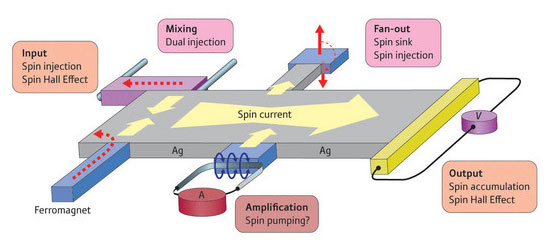| Posted: February 8, 2008 |
Silver keeps the electrons spinning |
|
(Nanowerk News) The future of computing may emerge not from electronics, but from ‘spintronics’. This new technology relies on the transport of electrons whose quantum spin states—or internal angular momentum—are all the same. YoshiChika Otani and Takashi Kimura at the University of Tokyo and the RIKEN Frontier Research System in Wako have been searching for the best materials to carry this ‘spin polarization’, and it appears that silver is a strong candidate ("Large Spin Accumulation in a Permalloy-Silver Lateral Spin Valve").
|
|
Many useful spin polarization phenomena arise in hybrid devices comprising both magnetic and non-magnetic materials. However, when spin-polarized electrons pass from a magnet into a non-magnet, they quickly lose their spin polarization in a process called spin-flip scattering. Therefore, one of the most crucial parameters for spintronics is the spin diffusion length of the non-magnet: the length that electrons travel before all their spin polarization is lost.
|
|
The RIKEN team built devices called lateral spin valves to test the spin diffusion lengths of different non-magnetic metals: copper, aluminum, and now silver. They found that the spin polarization of electrons remained very high after passing through a silver wire—implying that silver has a long spin diffusion length.
|
|
The result contradicts previous work by a group in the US ("Spin Injection in Mesoscopic Silver Wires: Experimental Test of Resistance Mismatch"), who predicted that silver has a very short diffusion length. Otani and Kimura believe this is because the US team did not take account of spin diffusion at the interfaces between the silver wire and the magnetic detectors used in their experiment.
|
|
By including the diffusion processes in their calculations, Otani and Kimura have proven that silver actually has a longer spin diffusion length than any other material studied so far. “What we found was quite different, demonstrating that our common understanding about the spin diffusion process was correct,” says Otani.
|
|
In related work, the RIKEN team recently developed the first method that provides complete control over the direction of spin polarization in copper, by using two spin injection needles ("Electrical Control of the Direction of Spin Accumulation"). Otani and Kimura believe their device could work just as well, if not better, with silver. However it is more difficult to fabricate devices from silver, so they hope to experiment with other materials soon.
|
 |
| Building blocks for a spin current circuit. Diagram shows a theoretical silver (Ag) spin current circuit, which exploits phenomena such as the Spin Hall Effect—the scattering of electron spins in a direction perpendicular to an electric field. (Image: Riken)
|
|
“Our future target is to develop ‘spin current circuits’ that manipulate the spin polarization as well as spin angular momentums,” says Otani. “This may be applied to the next generation of memory or logic circuit technology.”
|

